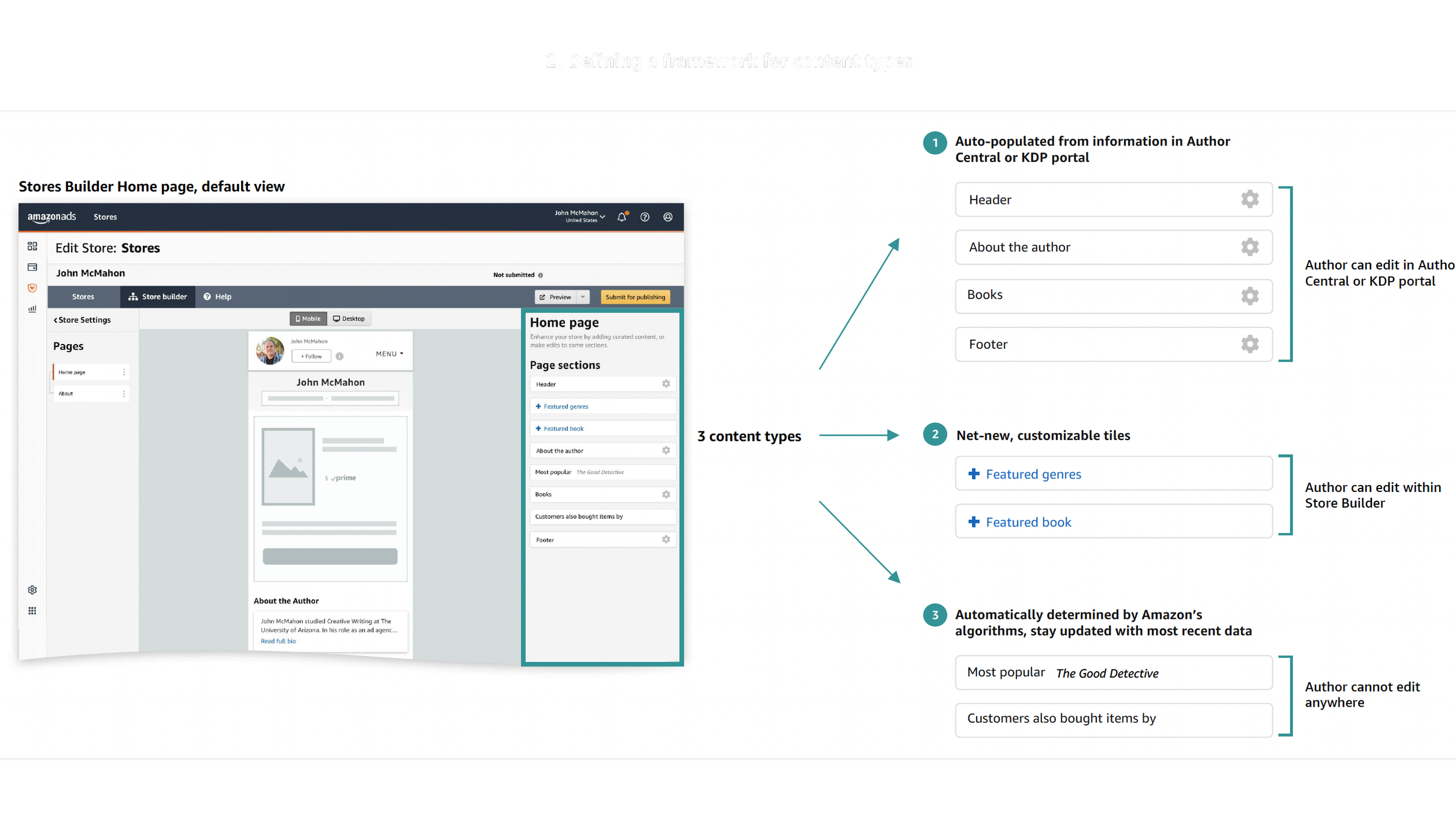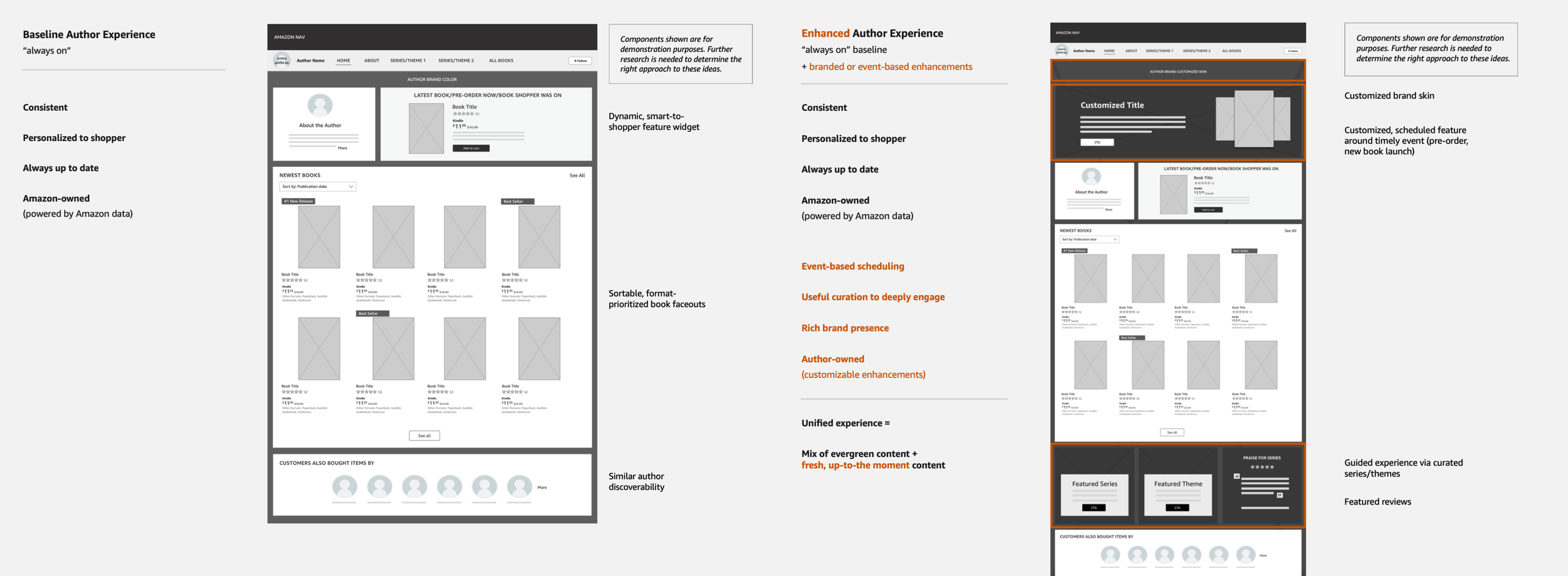Author Stores: Evolving customizable author storefronts + shaping scalable content contribution
Overview
Author Stores centralize content across multiple sources to create a curated and personalized shopping experience. These customizable storefronts enable authors to showcase their brand and books.
Role
Design Lead — led UX vision and end-to-end process, from initial concept to launch.
Drove 3-part research series that informed design.
Shaped scalable framework for content contribution.
Team
Core team: 2 Principal PMs, 6 FE + BE devs, 1 Principal UX Researcher
Partnered closely with multiple cross-org teams throughout.
“+31% increase”
“+21% increase”
“+6.5% increase”
Previous Author Pages
Previous Author Pages were built on an aging tech stack and had not seen significant CX updates in several years. These legacy pages were not mobile-optimized, and there were often content inconsistencies between desktop and mobile.
Voice of the author
“We love our readers and would do our best to woo more of them. Provide an easy to use gorgeous platform for us to do this, and we will. Build it, and we will come play.”
Customer needs - why explore a better author Store?
Curate an immersive brand experience
Authors were looking for ways to find new audiences. Free customizable Brand Stores were already leveraged by top brands on Amazon and well received by shoppers.
Drive more discoverability and reach
Some authors were finding ‘backdoors’ to creating a Brand Store, as Store building capabilities were not yet available to them. Stores were auto-linked from Search and product Detail Pages, helping brands generate higher sales.
Deepen reader-author connections and find the right read
Stores give authors tools to embed their voice and identity along the shopping journey — which helps build trust in their work, attract new readers, and ultimately leads shoppers to buy books.
Early explorations
Early approach — a unified experience
I explored a vision for a “unified experience” took the best of author pages (evergreen content) and Brand Stores capabilities (fresh, up-to-the-moment content). The baseline would be an “always on” Store powered by Amazon, while the enhanced experience would include opt-ins that were customizable and author-owned.
Lay of the land discovery
I researched how authors would market, brand, and set up their own websites. I found that authors often had large leading ‘hero’ promotions for new releases or pre-orders. Branding ranged from custom logos to assets inspired by book cover imagery. Editorial reviews and testimonials were common, as were series cards for larger catalog authors.
Early hi-fi concepts
I collaborated closely with my Principal PM partner on a concept document reviewed with cross-org leadership.
These early hi-fi mocks further the concept of locked areas (consistent within the template), vs. customizable areas (completely curated by the author). This ambitious vision included custom brand assets/features, smart event integration, customer testimonials, and editorial reviews.
User research survey: Author’s role in shopper purchase decisions
As a workaround to external research limitations due to the pandemic, we partnered with User Research to run a survey with 600+ “Book Lovers” in an internal community group (72% research or buy a new book weekly). A few key insights:
Genre is a key attribute when deciding on a book purchase.
Author’s sub-genres/tropes were consistently marked as “extremely helpful” when deciding on the next book.
Shoppers want to engage with authors on a deeper level.
Readers want an author’s book recommendations, are curious about their life goals and values, and want to know how they get inspired.
Amazon can provide greater inspiration for authors.
Although 72% followed authors on 1+ social platforms, only 25% found Amazon “extremely inspiring” in providing inspiration for new authors.
Refining the vision - controlled customization
Taking survey insights into account, I focused the CX vision around the concept of controlled customization. This direction involved smart-to-author templates based on catalog size.
Locked Store areas were consistent within the template and would always be up-to-date, personalized to the shopper, and powered by Amazon data. Opt-in, customizable areas would be curated by the author — these would help authors build a rich brand presence and help shoppers more deeply engage.
Small catalog
Large catalog
Smart-to-shopper tiles
I envisioned a smart-to-shopper slot that would dynamically pull in the most relevant content based on: 1) shopper’s past interactions and propensity with this author’s books; and 2) availability of recent author-curated content.
Mobile
On mobile, I simplified the core Books section to a grid faceout across all catalog sizes, for space and browsing efficiency. The auto-generated Store navigation was tucked behind a top-right menu.


Author Store Builder explorations
Auto-generation: Keeping a low barrier-to-entry
At this point, I started sketching out ideas for the Store Builder experience. Research told us that authors were novice marketers, and wanted to spend less time in marketing tools and more time writing. I envisioned auto-populating as much Store content as possible with what authors had already provided across Amazon systems. The Builder would pre-determine the template best suited for their catalog size to keep barrier-to-entry as low as possible.
Early Store builder mocks
Taking sketches to hi-fi mocks, I consulted closely with the Brand Stores Builder designer, working within the overall architecture of the existing Builder but making meaningful updates for author workflows take our controlled customization vision into account. Authors could opt-in to pre-defined customizable areas.
Easing author workflows to and from the Store Builder
Authors deal with 3 main Amazon touchpoints: 1) Author Central, 2) the Kindle Direct Publishing (KDP) portal, and 3) the Amazon Ads portal, in which the current Brand Stores builder lived. Author time in each touchpoint depended on whether they were traditionally published or were self-published in KDP, and their level of marketing activities.
In early conversations with these partner teams, I developed and iterated on workflow mappings of how we envisioned authors would ingress into the Store Builder from these main touchpoints in the author ecosystem.
At first, I split the workflows by author type, but eventually combined them into a unified mapping that captured an author coming in from any of the 3 entry points in a holistic view. How to handle P0 requirements of validating rightful ownership of a book/author name to be eligible for a Store, and making Store creation and new feature announcements present across touchpoints, were key considerations.
Shopper usability study
We partnered with User Research to test prototypes of the CX vision mocks with 18 shoppers who regularly shopped for books on Amazon. Shopper impressions of Author Stores were positive; when asked to rate the prototype vs. previous Author Pages (1=much worse; 5=much better), Author Stores was rated 4.8/5. Some key insights:
The Store provided confidence in decision making, with shoppers feeling like they have enough information to gauge interest in the author or one of their books.
The ‘hero’ for a new release, biography, and accolades badges provided confidence that the author was active and had well-rated work.
While positive accolades lent to credibility, shoppers seeked a more balanced perspective. They felt the author is unlikely to display negative reviews.
Shoppers wanted more refinement options, like language and age group filters.
Author research sessions
My PM and I conducted moderated sessions with 11 authors of mixed catalog size, genre, and series. Each author interacted with customized prototypes of the Store Homepage and Builder, so they could see their own books and catalog in the new experiences.
Overall, authors had positive impressions, noting a comprehensive improvement to Author Pages (which felt more cluttered and less engaging).
Key author insights: Store CX
“This would be great for building my brand, and promoting my brand as a one-stop shop to buy my books”
Authors found Stores valuable in driving purchases and preferred pointing shoppers to where it’s easier to do so.
Those with limited resources and technical expertise liked that Stores saved them time rather than manually update and upkeep their own website.
Authors saw the Store as a comprehensive and easy-to-navigate destination, with more abilities to bring their author voice.
Store Builder testing
We tested a small set of Store Builder customizations with authors: 1) a simplified Featured Book Hero with a light/dark theme; 2) selecting 2 genres that display globally at top-of-Store, 3) a mini Featured Book slot on in-Store series pages; and 4) custom image on About page.


Key author insights: Store Builder
“Amazon’s doing the heavy lifting for you. I can immediately tell this is optimized for conversion, which as an author makes me happy”
All authors found auto-population to be useful and a time-saver, and understood the concept of controlled customization.
Expected levels of customization varied. Some authors wanted more control over Store ordering, while others trusted Amazon’s ability to optimize.
Piloting a lean experience
The pilot CX we launched was a lean experience, focused on the baseline Store and core catalog browsing functionality that we could auto-generate across all authors. This included 2 sub-pages: a simple About page housing the author’s full biography and a utility-focused All Books page.
We tested this Store CX in an experiment with 3K authors. This allowed us to move quickly and pilot test the default Author Store against existing Author Pages, and isolate impact of new CX features introduced thereafter.
Larger catalog (7-16 titles)
Smaller catalog (1-5 titles)
In-Stores Quicklook
The ‘Quick look’ icon on the lower-left of book covers opened a modal or bottom sheet with more details. Shoppers are able browse books in more detail and add to cart without leaving the Store, easing the need to ping-pong between multiple product Detail Pages.
A pivot in scope + sequencing
After the CX pilot, original plans were to launch a Store Builder pilot with a small set of authors — but this unfortunately got de-scoped for 2 key reasons: 1) tech resource constraints, and 2) the CX pilot performed well against Author Pages, without any customizations yet, that we felt confident prioritizing a GA launch of that baseline experience first.
Before this pivot, I had fleshed out P0 Store Builder designs, with a sampling of key refinements below.




Cards brainstorming with Books partners
As we were ramping to launch the P0 baseline experience at a wider scale, our Books partners had started work developing and collecting new “cards” content that could be reusable across books pages, including Author Stores. The first 2 cards included: 1) a personalized ‘smart' catalog; and 2) author-curated book recommendations, but there would be more content introduced in the future.
I co-ran brainstorming sessions with Books product + design partners on how we might integrate this new content in the Store. This informed our approach for a P0 cards framework and content prioritization across Store pages as we scale.
P0 Cards framework for future content contributions at scale
As we drove toward a new unified author experience that integrated Stores capabilities with previous Author Pages content, we planned to combine different content types by introducing a content framework. We defined card classifications, the core shopper mission they mapped to, and associated ranking criteria for each.
This framework set up Author Stores as a central surface that teams across the Books organization can contribute to — while ensuring alignment to an overarching strategy based on shopper mission and commonly understood ranking criteria.
This would enable a durable approach to experimentation and introducing new content to the Store at scale.
Applying the Cards framework to the P0 Store
Applying the framework, our MLP experience ranked author-curated and Amazon-generated cards. The sections highlighted in orange mark how the first set of cards content planned to be introduced to the P0 Store, as well as how other auto-generated content would be classified and ranked.


Some of this Cards content ultimately got scoped back or simplified for the P0 GA launch. For example, for author book recommendations, we originally thought we would be able to separate out an author’s 1P recs (from their own catalog) from their 3P recs (for books by other authors). However, for P0 these were mixed within the same list, so ultimately ended up only in the “Related discovery” zone at the bottom of Home.
🚀 GA launch in US
In December 2022, we launched the first Author Stores milestone, migrating 1.3MM+ legacy author pages in the US to a baseline auto-generated Store experience that was focused on catalog browsing utility and aggregating existing content from multiple sources. This included Sorting functionality on the Home and All Books pages, and integrating lean P0 versions of the personalized smart catalog and author book recommendations cards.
Impact
In the first 30 days, with 21.3MM visits across 1MM+ author stores, we observed:
+31% increase in attributed books gross sales
+21% increase in attributed books total units
🚀 GA launch worldwide (WW)
After launching the baseline Store in the US, it was critical to enable some key improvements prior to scaling the experience worldwide (WW). This included: 1) filtering by book format and Kindle Unlimited availability; and 2) making the Store aware of a customer’s reading subscriptions and book ownership status. In August 2023 (EU + UK) and December 2023 (rest of world marketplaces), we completed the launch of the Author Stores experience WW.
Impact
This expanded Author Stores from 1.2MM to 3.8MM+ authors, migrated 360MM+ annualized Author Page traffic to Stores, and supported the launch of Author Stores as a landing page to drive ads demand. The feature improvements drove:
+6.5% increase in attributed books gross sales
Future vision and evolution
Smart brand content integration
Over time, we envisioned Author Stores evolving to incorporate brand content from multiple sources (Store Builder, Author Central, Posts, Video, and Amazon Live). Over time, the Homepage would include dynamic, ranked cards across defined page slots to personalize content relevant to the shopper’s context, mission, and propensity with the author.
Learnings and Author Stores 2.0
Post worldwide launch, we worked closely with our Books team partners to evaluate how the next evolution of Author Stores could take shape. A few key factors influenced this direction:
1. Availability of GenAI tools
Amazon GenAI tools were being launched at scale, democratizing ability to create high-quality images/video that felt true to an author’s brand and easing original concerns of keeping barrier-to-entry low for authors.
2. Shopper click data
We learned that Smart Catalog, Product Grid, and Most Popular drove the most clicks, confirming importance of top-of-Store content. Since the bio had low engagement, and Most Popular duplicated the first book in the Product Grid, we prioritized the personalized Smart Catalog higher up.
3. Books design system development
At this point, a wider Books design system was starting to be introduced on other key books surfaces. We aimed for Stores to align with these components and styles for a holistic experience across touchpoints.




























